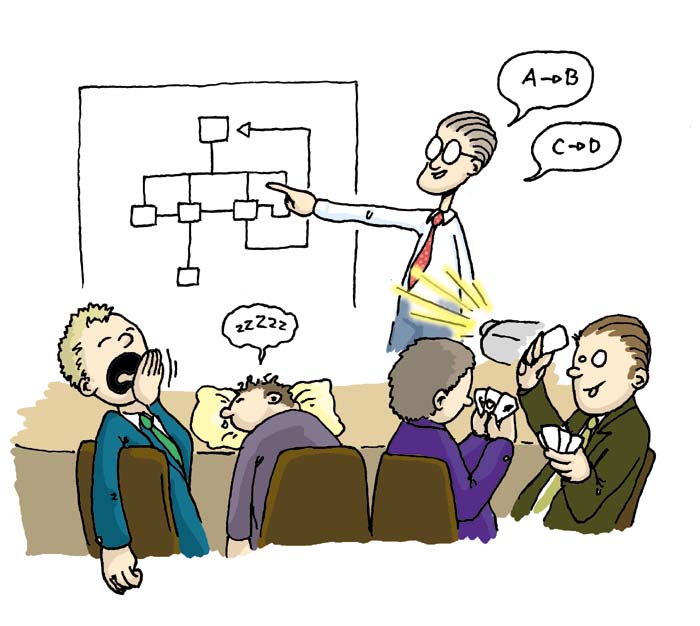The questions you have to pay attention when teaching with PPT
by , 11-23-2011 at 04:56 AM (1157 Views)
I have been using a two-part approach to teaching PowerPoint skills in the classroom. This happens within a required core management communication course in an MBA-level curriculum, with a highly diverse student body, especially in terms of communication skills. About half of our students are international, and a majority of those are nonnative English speakers. In all student categories, however, there is a wide range of communication skill and experience
My experience with this kind of session has been that in the process of working through 5 to 10 different slide sets, the discussion invariably covers every main principle of effective visual aid design. Moreover, using actual student works in progress as material makes the session very relevant and the lessons learned more vivid.
PowerPoint is also easy to use. The genius of Microsoft is that they do facilitate us in using this great tool by making it so easy to take advantage of all of PowerPoint's fantastic tools. In a classroom setting, PowerPoint alone could represent one of the biggest revolutions in how to present information to students in a long time. But it's a good idea to think through how to use the tool and have some ground rules for how to use it so you get the maximum value from PowerPoint without becoming abusive of its powers. And we can use PPT to video software to help teachers convert PowerPoint to video, what’s more, the PowerPoint to Flash Converter to create Flash presentations and E-Learning courses in a few minutes with its value-added features, According to the Dual Coding Theory; we can process words and pictures or animation simultaneously quite effectively. By tapping into the Dual Coding Theory, learning can be enhanced if your presentation uses both visual and verbal format. Humans can absorb information quite easily if shown an image and told about the image at the same time. Our mind naturally creates both visual and verbalrepresentations in our memory.
Tip when working with PowerPoint in an educational setting is to never turn your back on your students. You need to have eye contact with them at all times when you are teaching. So know your presentation well so you don't have to turn and look at the screen during the course of the lesson. To enhance your understanding of using PowerPoint to aid better learning and communication, don't just use the templates, or rely on other's work from a previous lesson plan, create your own. Get some professional training in PowerPoint and then you can really put the fun into learning, no matter the age or ability of your audience. Maintain a consistency to the design of your PowerPoint slides. This means using one single color or background scheme for the entire show. Consistency also applies to the motion of bulleted lists. There are dozens of presentation styles for bulleted lists that PowerPoint supports. You can have your bullet points fly in from the side, bounce in or fade in from nothing to something and then fade away again.
My approach to teaching PowerPoint is a two-part skill-building process that combines a coach approach and a "writer's workshop" model. Two PowerPoint workshop sessions are part of a larger project, with a final deliverable of a 3- to 4-minute live presentation using PowerPoint. The assignment specifics vary from year to year and sometimes have included a formal written report as well. This approach to the "PowerPoint problem" works regardless of the presence or the absence of the written report requirement, the how to convert PPT to video is a needed tips. It also sidesteps the question of content development methodology and the question of whether to "write" the presentation or develop the visuals first. This last point is a deliberate strategic choice, as I have discovered that, more and more, students use PowerPoint as a content development tool, much like the outline features of Microsoft Word, and not just for presentations--a use of the tool that is becoming common in the workplace as well.
Show them your presentation. Now that they have a topic, and a general idea of what PowerPoint is, you need to show them an example. Teach kids to use PowerPoint with a visual example of what a PowerPoint presentation should look like. Now that they have a basic idea of PowerPoint, they can look for the things you talked about, and hopefully get ideas for their presentation. It's a good idea to ask them to write down things they like about your presentation. This way they pay closer attention, and are more likely to incorporate those things into their own PowerPoint presentations. Your presentation may be the most effective aspect of teaching kids to use PowerPoint. PowerPoint can employ animation with verbs to illustrate meanings more clearly: pupils can see the picture of someone running while looking at the name of the verb to run on screen. With PowerPoint, animation can bring life to a subject that may otherwise be quite dry. Suddenly your presentation becomes interactive rather than just a slide show.
Through more than two years of practicing teaching courseware by using PowerPoint, we feel it is a very good teaching way, which can improve teaching efficiency and quality, better inspire students' interest in learning. Such as mentioned in the example, the teacher's experimental demonstration through the video projector showing in the sight of all the students, so that the students have the personal experience, it is helpful for understanding.











 Email Blog Entry
Email Blog Entry
